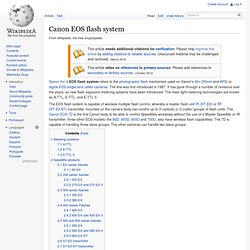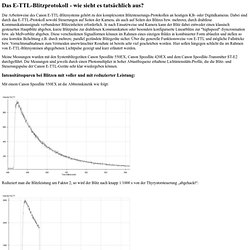

Canon 580EX-II Hot Shoe Fix Pinout - Day 336 of Project 365. Canon EOS flash system. Canon Inc.'s EOS flash system refers to the photographic flash mechanism used on Canon's film (35mm and APS) or digital EOS single-lens reflex cameras.

The line was first introduced in 1987. It has gone through a number of revisions over the years, as new flash exposure metering systems have been introduced. The main light-metering technologies are known as A-TTL, E-TTL, and E-TTL II. The EOS flash system is capable of wireless multiple flash control, whereby a master flash unit IR (ST-E2) or RF (ST-E3-RT) transmitter mounted on the camera body can control up to 3 (optical) or 5 (radio) groups of flash units.
Metering systems[edit] Canon has introduced several different metering systems for its flash products: A-TTL, E-TTL, and E-TTL II. A-TTL[edit] A-TTL is an initialism that stands for Advanced-Through The Lens flash metering. E-TTL[edit] E-TTL II[edit] Speedlite products[edit] EX series flashes[edit] 90 EX[edit] 200 series flashes[edit] 220 EX[edit] 270 EX and 270 EX II[edit] 320 EX[edit] Back. BestOfferBuy E-TTL Kamera Blitz Synchronisierung Schnur: Amazon.de: Kamera & Foto. Programming, thoughts and experiments. Bill Grundmann's Blog. This is a continuing story from and previous posts.

Good news! I found out today that the drop of CLK to ground (after command message 0xb4 0x3d) before the “X” pin drops is exactly 4.00 msec. This has been measured several times. This is good as we now have a leading indicator when the flash is requested to do its job! This is sufficient time for even wireless modes. I’m working on a collective document that describes everything that I’ve found so far. Bill Like this: Like Loading... Tags: Arduino, canon, ettl, shutter, Speedlite 580ex, xsi.
Bill Grundmann's Blog. Canon Flash E-TTL Protocol. I have started a project to build a remote trigger for canon flashes using Arduino and RFBee/BlueTooth Bee.

In order to do this I need to know the protocol camera and flash uses, so that Arduino device can partially simulate a flash/camera. I did not have much success in googling about this protocol, however I found a few good resources that helped me to start:Flash System Patent US6404987Bill Grundmann’s blog I used Bill’s translation circuit to convert the camer/flash communication into binary signal with 0/1 voltage levels needed by USB Logic Analyzer.
I have saved the session with data using Logic Software multiple times to assure that sniffing was done properly. Each time the first communication part was the same. Below is the full communication from turning on camera and flash until firing the flash in ETTL mode. From starting up to the first message, it takes 25ms. And the exported data of this message in csv format can be downloaded here. More to come soon. Messungen zum Canon E-TTL Protokoll. Das E-TTL-Blitzprotokoll - wie sieht es tatsächlich aus?

Die Arbeitsweise des Canon E-TTL-Blitzsystems gehört zu den komplexesten Blitzsteuerungs-Protokollen an heutigen KB- oder Digitalkameras. Dabei sind durch das E-TTL-Protokoll sowohl Steuerungen auf Seiten der Kamera, als auch auf Seiten des Blitzes bzw. mehrerer, durch drahtlose Kommunikationssignale verbundener Blitzeinheiten erforderlich. Je nach Einsatzweise und Kamera kann der Blitz dabei entweder einen klassisch gesteuerten Hauptblitz abgeben, kurze Blitzpulse zur drahtlosen Kommunikation oder besonders konfiguruerte Linearblitze zur "highspeed"-Syncronisation bzw. als Meßvorblitz abgeben.
Diese verschiedenen Signalformen können im Rahmen eines einzigen Bildes in kombinierter Form ablaufen und stellen so eine korrekte Belichtung z.B. durch mehrere, parallel gezündete Blitzgeräte sicher. Über die generelle Funktionsweise von E-TTL und mögliche Fallstricke bzw. Mit einem Canon Speedlite 550EX ist die Abbrennkinetik wie folgt: